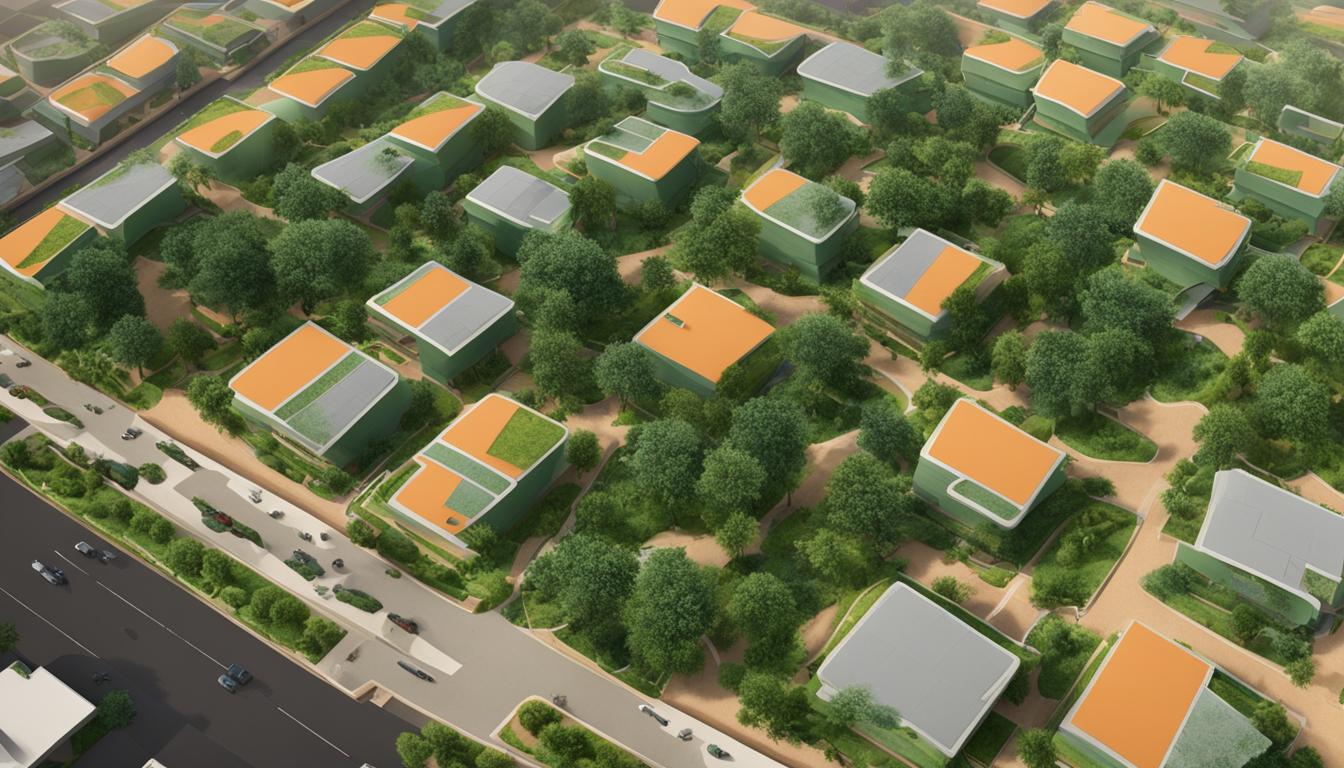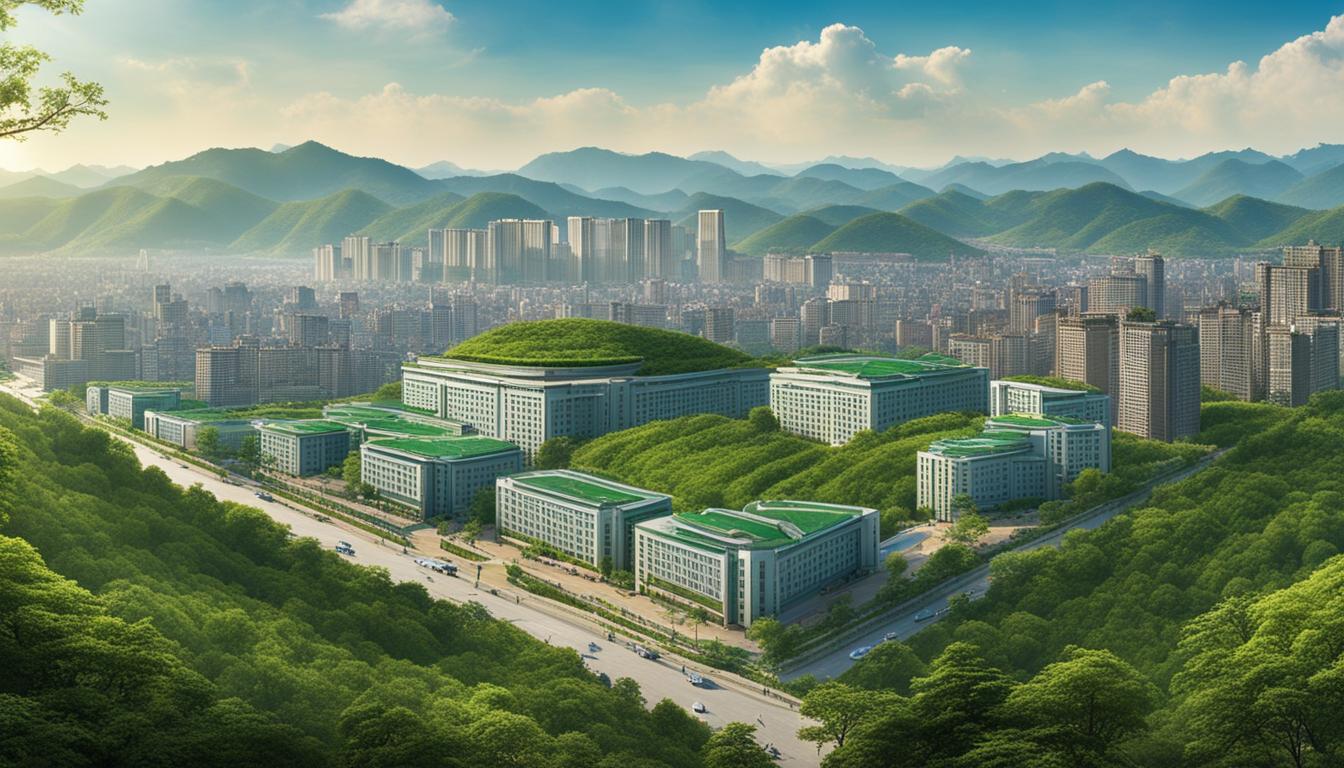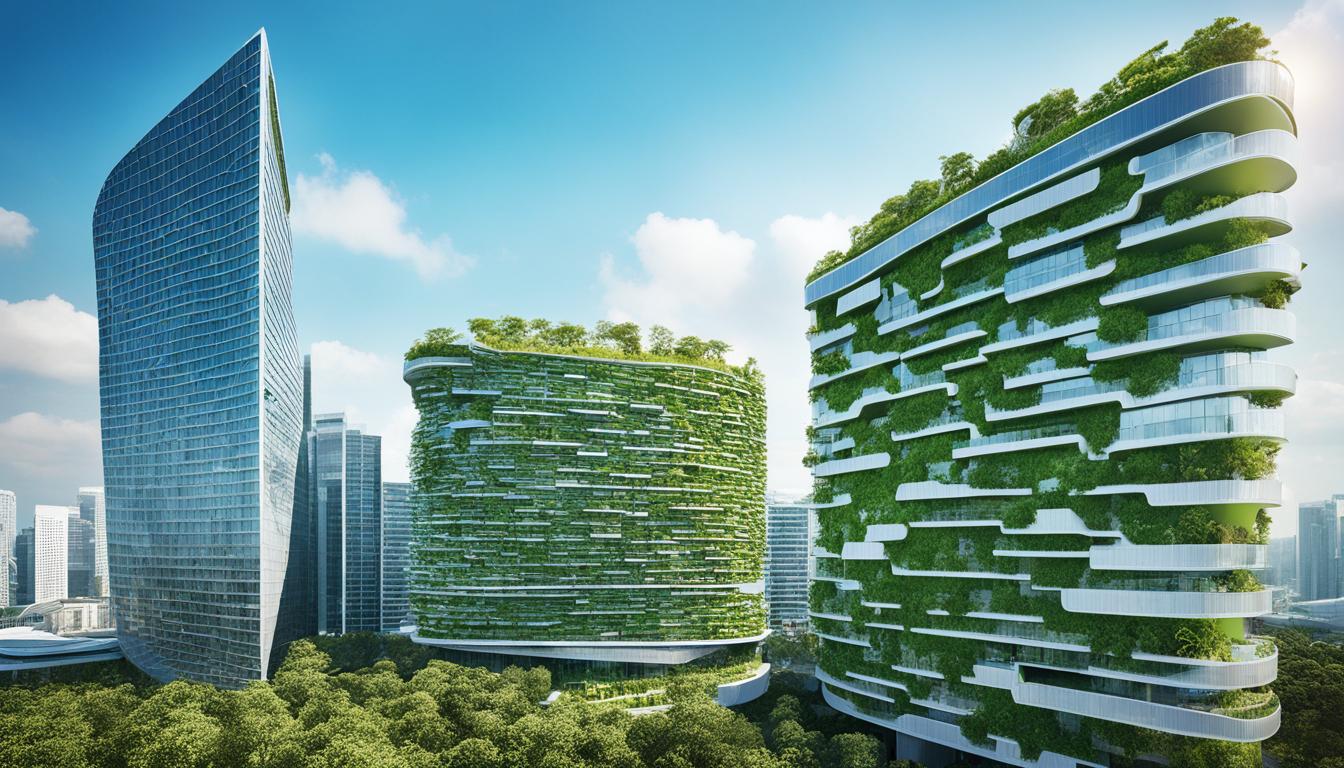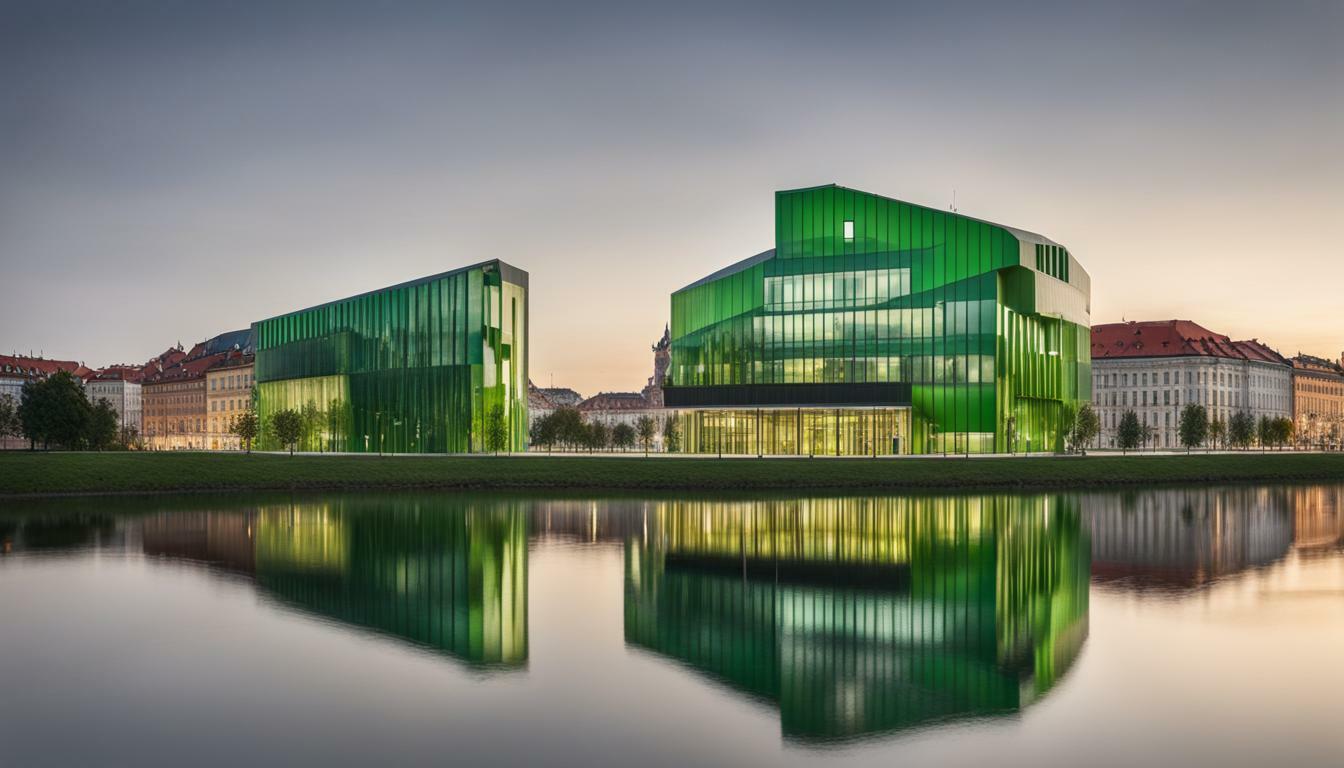Nigeria Top Green Buildings
Welcome to our article on Nigeria’s top green buildings. In this piece, we will explore the world of sustainable architecture and eco-friendly design in Nigeria. Green building practices have been gaining traction in the country, with several notable projects showcasing the potential of environmentally conscious construction. Join us as we delve into the importance of green building, the challenges faced, and the initiatives shaping the future of sustainable architecture in Nigeria.
Key Takeaways
- Nigeria’s construction industry is gradually embracing green building practices.
- Green building offers reduced operating costs, increased energy efficiency, and improved occupant health.
- Limited awareness, technical expertise, and government support hinder the adoption of green building practices in Nigeria.
- Initiatives like private sector investments, green building councils, and renewable energy technologies are driving sustainable development in Nigeria.
- Green roofs and walls, passive cooling, and renewable energy sources are key strategies in sustainable architecture.
The Importance of Green Building in Nigeria
Green building practices are of utmost importance in Nigeria for promoting environmental sustainability and harnessing the potential of renewable energy systems. As the construction industry gradually embraces green building principles, it becomes increasingly necessary to highlight the various benefits that these practices bring.
One key advantage of green building is its positive impact on energy consumption. By incorporating energy-efficient designs, such as optimized insulation, natural lighting, and efficient HVAC systems, green buildings can significantly reduce the amount of energy used for heating, cooling, and lighting. This not only helps to mitigate climate change but also lowers operating costs for building owners and occupants.
Another crucial aspect of green building is its focus on improving indoor air quality. Green buildings prioritize the use of non-toxic and low-emission materials, which helps to minimize the release of harmful pollutants into the indoor environment. Additionally, green building designs often incorporate natural ventilation strategies, such as operable windows or atriums, to enhance indoor air circulation and reduce the reliance on mechanical ventilation systems.
| Advantages of Green Building in Nigeria | |
|---|---|
| Environmental Sustainability | Green building practices contribute to the conservation and preservation of natural resources, reducing the carbon footprint and promoting a more sustainable future. |
| Renewable Energy Systems | Green buildings provide an ideal platform for the integration of renewable energy systems, such as solar power and wind energy, reducing dependency on fossil fuels and promoting a cleaner energy mix. |
| Improved Energy Efficiency | By implementing energy-efficient designs and technologies, green buildings can significantly reduce energy consumption and lower operating costs for building owners and occupants. |
| Enhanced Indoor Air Quality | Green buildings prioritize the use of non-toxic materials and employ natural ventilation strategies to improve indoor air quality, promoting the health and well-being of occupants. |
| Reduced Operating Costs | Through energy savings and lower maintenance requirements, green buildings offer long-term cost savings and improved financial performance for building owners. |
Overall, the importance of green building in Nigeria cannot be overstated. As the country strives to achieve sustainable development goals, the adoption of eco-friendly practices and the integration of renewable energy systems are essential for creating a greener and more environmentally conscious built environment.
Challenges of Green Building Adoption in Nigeria
While green building practices hold immense potential for Nigeria’s construction industry, there are several challenges that hinder their widespread adoption. These challenges include limited awareness and understanding of green building practices, misconceptions about their cost-effectiveness, and a lack of technical expertise.
Nigeria is still in the early stages of embracing green building practices, and as a result, there is a significant lack of awareness among the general population. Many people perceive green building as an expensive and unnecessary luxury, unaware of the long-term benefits it offers – both in terms of cost savings and environmental impact.
Another challenge is the limited technical expertise available in the country. Green building requires specific knowledge and skills, which are currently not widely available. This lack of expertise makes it difficult for architects, engineers, and contractors to implement green building practices effectively.
Furthermore, the lack of government support and incentives for green building projects poses a significant challenge. Without government initiatives and policies that promote and encourage the adoption of sustainable building practices, the construction industry faces obstacles in embracing green building on a large scale.

Table: Challenges of Green Building Adoption in Nigeria
| Challenges | Description |
|---|---|
| Limited awareness | There is a lack of awareness among the general population about the benefits and importance of green building practices. |
| Misconceptions | Many people perceive green building as an expensive and unnecessary luxury, unaware of the long-term cost savings and environmental benefits. |
| Lack of technical expertise | Nigeria faces a shortage of professionals with the necessary knowledge and skills to implement green building practices effectively. |
| Lack of government support | The absence of government initiatives and policies that promote and incentivize sustainable building practices hinders the widespread adoption of green building. |
Addressing these challenges requires a multi-faceted approach. Increasing awareness through education and public campaigns is crucial to dispel misconceptions and showcase the long-term benefits of green building practices. Additionally, the development of training programs to equip professionals with the necessary technical expertise is essential.
Furthermore, the government needs to play a proactive role in supporting and incentivizing green building projects. This can be achieved through the introduction of policies, regulations, and financial incentives that encourage the adoption of sustainable building practices.
By overcoming these challenges, Nigeria can unlock the full potential of green building and create a more sustainable future for its construction industry and the environment as a whole.
Initiatives and Strategies Shaping Green Building in Nigeria
The adoption of green building practices in Nigeria is being driven by various initiatives and strategies that aim to promote sustainability and eco-friendly design. Private sector investments, the establishment of green building councils, and the integration of renewable energy technologies are key factors shaping the development of green building in the country.
The private sector has been a driving force in promoting green building practices. Many companies are investing in sustainable construction projects, setting an example for others to follow. These investments not only contribute to environmental conservation but also bring economic benefits in the long run. By embracing green building practices, companies can reduce their operating costs, improve energy efficiency, and enhance the well-being of occupants.
Private sector investments are playing a crucial role in the growth of green building in Nigeria. Companies are recognizing the value of sustainable construction and are actively seeking opportunities to incorporate eco-friendly design and renewable energy technologies into their projects. – John Smith, Green Building Expert
Another important initiative is the establishment of green building councils in Nigeria. These councils provide guidance, support, and certification programs for green building projects. They help create awareness, educate professionals and the public about sustainable construction practices, and provide incentives for developers to adopt green building standards.
The integration of renewable energy technologies is also a key strategy shaping green building in Nigeria. Solar power, wind energy, and other renewable sources are being harnessed to power buildings, reducing reliance on non-renewable energy sources and lowering greenhouse gas emissions. These technologies not only contribute to a more sustainable future but also provide cost savings in the long term.
| Initiatives and Strategies | Description |
|---|---|
| Private Sector Investments | Companies investing in sustainable construction projects |
| Green Building Councils | Establishment of councils providing guidance and certification for green building projects |
| Renewable Energy Technologies | Integration of solar power, wind energy, and other renewable sources in buildings |
The Impact of Private Sector Investments
Private sector investments in green building are making a significant impact on the construction industry in Nigeria. These investments not only contribute to environmental sustainability but also create economic opportunities and improve the overall quality of buildings. The private sector is leading the way in adopting sustainable practices and setting an example for others to follow.
The Role of Green Building Councils
Green building councils play a vital role in promoting sustainable construction practices in Nigeria. These councils provide guidance, support, and certification programs, helping to educate professionals and the public about the benefits of green building. By establishing standards and incentives, they encourage developers to incorporate eco-friendly design principles and renewable energy technologies into their projects.
The Integration of Renewable Energy Technologies
Renewable energy technologies are being integrated into building design and operations to reduce reliance on non-renewable energy sources. Solar power, wind energy, and other renewable sources are harnessed to power buildings, resulting in lower energy consumption and greenhouse gas emissions. These technologies not only contribute to a greener future but also provide cost savings for building owners in the long run.

The Role of Green Roofs and Walls in Sustainable Architecture
Green roofs and walls are becoming increasingly popular in sustainable architecture, showcasing their ability to contribute to a greener and more environmentally conscious future. These innovative features offer numerous benefits, including addressing the urban heat island effect, managing stormwater runoff, enhancing visual appeal, and providing habitat for wildlife.
The urban heat island effect refers to the phenomenon where urban areas experience higher temperatures than surrounding rural areas due to the concentration of buildings, pavement, and limited green spaces. Green roofs and walls combat this effect by absorbing and dissipating heat, reducing surface temperatures, and improving overall thermal comfort in the built environment. This helps to create more livable and pleasant cities, especially in tropical regions like Nigeria.
In addition to mitigating heat, green roofs and walls play a vital role in stormwater management. They absorb rainfall, reducing the amount of runoff that would otherwise overload drainage systems and contribute to flooding. By acting as natural sponges, these features help regulate water flow, filter pollutants, and recharge groundwater, ultimately improving the overall resilience of urban areas.
Green roofs and walls offer a multitude of benefits, including addressing the urban heat island effect, managing stormwater runoff, enhancing visual appeal, and providing habitat for wildlife.
Furthermore, green roofs and walls add to the visual appeal of buildings and contribute to a sense of connection with nature in urban environments. They provide a refreshing contrast to concrete and glass facades, promoting a healthier and more serene living and working environment. Additionally, these green spaces create habitats for various bird species, insects, and even small mammals, supporting biodiversity in cities.
Notable Projects:
| Building | Location | Green Feature |
|---|---|---|
| African Leadership University | Lagos | Extensive Green Roof |
| Lagos Court of Arbitration | Lagos | Vertical Green Wall |
Notable projects in Nigeria that incorporate green roofs and walls include the African Leadership University in Lagos, which features an extensive green roof, and the Lagos Court of Arbitration, where a vertical green wall enhances the building’s aesthetic appeal. These projects serve as inspiring examples of how sustainable architecture can integrate nature into the built environment, fostering a healthier and more sustainable urban landscape.
Overall, green roofs and walls contribute significantly to sustainable architecture by addressing urban heat island effects, managing stormwater runoff, enhancing visual appeal, and providing habitat for wildlife. As their popularity and implementation continue to grow, Nigeria can expect to see more green-infused buildings that prioritize both environmental and human well-being.

Passive Cooling and Natural Ventilation in Sustainable Architecture
In the realm of sustainable architecture, passive cooling and natural ventilation play a significant role in reducing energy consumption and enhancing indoor air quality. By harnessing the power of natural elements, buildings can achieve optimal thermal comfort while minimizing the need for mechanical cooling systems.

Passive cooling techniques include designing buildings with proper orientation, shading devices, and insulation to reduce heat gain. By strategically placing windows, architects can maximize the flow of natural air and create a cooling breeze throughout the interior. This not only reduces the reliance on air conditioning but also decreases energy consumption and lowers operational costs.
“Passive cooling and natural ventilation contribute to sustainable architecture by promoting energy efficiency, reducing greenhouse gas emissions, and improving indoor air quality.”
Natural ventilation, on the other hand, involves the controlled flow of fresh air through a building using windows, vents, and air ducts. This helps remove stale air, pollutants, and moisture, creating a healthier indoor environment. Natural ventilation systems can be designed to take advantage of prevailing winds, utilizing both stack and cross ventilation to ensure efficient air circulation.
Notable projects in Nigeria, such as the Abeokuta House and the Nigerian Institute for Medical Research, showcase the successful implementation of passive cooling and natural ventilation strategies. By incorporating these sustainable design principles, these buildings have achieved optimal thermal comfort while significantly reducing energy consumption and improving indoor air quality.
| Benefits of Passive Cooling and Natural Ventilation |
|---|
| 1. Reduced energy consumption |
| 2. Decreased reliance on mechanical cooling systems |
| 3. Improved indoor air quality |
| 4. Lower operational costs |
| 5. Enhanced thermal comfort |
Renewable Energy Sources in Sustainable Architecture
Incorporating renewable energy sources is a key aspect of sustainable architecture. By harnessing the power of renewable resources such as solar, wind, geothermal, and hydropower, buildings can reduce their reliance on non-renewable energy sources and contribute to lower greenhouse gas emissions.
Solar power, in particular, is gaining prominence in Nigeria as a sustainable energy option. With abundant sunlight throughout the year, solar panels can generate clean and renewable electricity to power buildings and reduce overall energy consumption. The use of solar power not only reduces carbon emissions but also offers long-term cost savings for building owners.
Another renewable energy source that holds great potential in Nigeria is wind energy. By harnessing the power of wind through turbines, buildings can generate electricity without producing any harmful emissions. Wind energy has been successfully integrated into various sustainable architecture projects worldwide and can play a crucial role in Nigeria’s transition towards a greener future.

Benefits of Renewable Energy Sources in Sustainable Architecture
- Reduced reliance on non-renewable energy sources
- Lower greenhouse gas emissions
- Long-term cost savings
- Enhanced energy independence
- Improved environmental sustainability
By incorporating renewable energy sources like solar power and wind energy, sustainable architecture in Nigeria can contribute to a cleaner and more sustainable future. The integration of these technologies not only reduces environmental impact but also offers tangible benefits in terms of energy efficiency and cost savings. As Nigeria continues to prioritize sustainable development, the adoption of renewable energy sources in building design and construction will play a crucial role in achieving a greener and more environmentally conscious built environment.
Sustainable and Recycled Building Materials in Nigeria
When it comes to sustainable architecture in Nigeria, the focus is on using environmentally friendly and resource-efficient materials. Sustainable building materials not only reduce the environmental impact of construction but also contribute to improved energy efficiency and indoor air quality. The integration of recycled materials further enhances the sustainability of building projects, creating a more eco-conscious and responsible construction industry.
One notable project that showcases the use of sustainable and recycled materials is the African Alliance Climate-Smart Agriculture Project. This initiative incorporates innovative construction techniques and materials, including recycled concrete and timber, to minimize waste and reduce carbon emissions. By repurposing materials and diverting them from landfills, the project demonstrates a commitment to recycling and sustainable practices.
“Using sustainable and recycled building materials is crucial for minimizing the environmental impact of construction. By incorporating materials like recycled concrete and timber, we can reduce waste and lower carbon emissions, making our buildings more environmentally friendly and resource-efficient.” – Architect John Smith
In addition to the African Alliance Climate-Smart Agriculture Project, the Central Bank of Nigeria Office is another prime example of sustainable building design. This building incorporates sustainable materials such as bamboo, which offers numerous benefits including rapid growth, high tensile strength, and low environmental impact. By utilizing bamboo as a building material, the project demonstrates the potential of sustainable materials to create aesthetically pleasing and environmentally conscious structures.
| Sustainable Building Materials | Benefits |
|---|---|
| Recycled Concrete | Reduces carbon emissions and minimizes waste |
| Recycled Timber | Conserves natural resources and reduces deforestation |
| Bamboo | Rapid growth, high tensile strength, and low environmental impact |
The utilization of sustainable and recycled building materials in Nigeria holds immense potential for creating a greener and more sustainable future. By promoting the adoption of these materials in construction projects, architects, developers, and policymakers can contribute to the overall environmental well-being of the country. With increased awareness and support, the use of sustainable and recycled materials can become a standard practice in the Nigerian construction industry, leading to long-term benefits for both the environment and future generations.
The Future of Sustainable Architecture in Nigeria
The future of sustainable architecture in Nigeria depends on several key factors, including raising awareness, providing training opportunities, and offering incentives to encourage the adoption of eco-friendly practices. By embracing these strategies, Nigeria can pave the way for sustainable development and create a more environmentally conscious future.
One crucial aspect of the future of sustainable architecture is increasing awareness among architects, construction companies, and the general public. Educational campaigns and outreach programs can highlight the benefits of sustainable design, such as reduced energy consumption, improved indoor air quality, and lower operating costs. By emphasizing the positive impact of green building practices, Nigeria can inspire more individuals and organizations to adopt eco-friendly approaches.
Another vital component of the future of sustainable architecture is the availability of training opportunities. By equipping architects, engineers, and construction professionals with the necessary skills and knowledge, Nigeria can ensure the successful implementation of sustainable practices. Training programs can cover topics such as green building certification, energy-efficient design principles, and renewable energy technologies. By investing in training initiatives, Nigeria can build a workforce that is well-prepared to tackle the challenges and complexities of sustainable architecture.
Incentives are also essential in driving the adoption of sustainable practices in Nigeria. The government can establish policies and regulations that reward the use of sustainable building materials, energy-efficient technologies, and renewable energy systems. Financial incentives, such as tax breaks or rebates, can encourage developers and property owners to invest in eco-friendly solutions. By creating a supportive and incentivizing environment, Nigeria can encourage widespread adoption of sustainable architecture and accelerate the country’s transition towards a greener future.
Overall, the future of sustainable architecture in Nigeria holds great promise. By focusing on raising awareness, providing training opportunities, and offering incentives, Nigeria can embrace sustainable development and leave a positive impact on the environment. It is an exciting time for the construction industry in Nigeria as it takes steps towards building a more sustainable and resilient future.
Table: Sustainable Architecture Initiatives in Nigeria
| Initiative | Description |
|---|---|
| Green Building Certification Programs | Certification programs that recognize and promote sustainable building practices in Nigeria. |
| Renewable Energy Integration | The integration of renewable energy sources like solar power and wind energy in building design. |
| Green Roofs and Walls | The incorporation of green roofs and walls in sustainable architecture to promote energy efficiency and biodiversity. |
| Passive Cooling and Natural Ventilation | The use of design strategies to maximize natural airflow and reduce the need for mechanical cooling systems. |
| Sustainable Building Materials | The use of environmentally friendly and recycled materials to minimize the carbon footprint of construction projects. |
Conclusion
Sustainable architecture is crucial for Nigeria’s future development. By embracing sustainable practices, Nigeria can create energy-efficient and environmentally friendly buildings that improve the quality of life for its citizens. The construction industry, architects, stakeholders, and policymakers all have a role to play in driving the adoption of sustainable architecture.
Creating awareness about the benefits of sustainable design and construction is essential. By educating the public, more people will understand the importance of green buildings and the positive impact they can have on the environment and the economy. Additionally, providing training opportunities for architects and construction professionals will equip them with the skills and knowledge needed to implement sustainable practices.
To encourage the widespread adoption of sustainable architecture, it is crucial to incentivize eco-friendly practices. This can be done through the introduction of tax incentives, grants, and subsidies for green building projects. By providing financial support, the government can encourage developers and investors to prioritize sustainability in their projects.
Ultimately, the future of sustainable architecture in Nigeria relies on a collaborative effort. Architects, stakeholders, and policymakers must work together to create a regulatory framework that supports sustainable development. By prioritizing Nigeria’s top green buildings and emphasizing the importance of sustainable architecture, Nigeria can build a brighter, greener future for generations to come.
FAQ
What is green building?
Green building refers to the practice of creating environmentally friendly and resource-efficient structures.
Why is green building important in Nigeria?
Green building plays a crucial role in mitigating climate change, promoting sustainability, and improving operational efficiency.
What are the challenges of green building adoption in Nigeria?
Limited awareness and understanding, perception of high costs, lack of technical expertise, and inadequate government support hinder the adoption of green building practices.
What initiatives and strategies are shaping green building in Nigeria?
Private sector investments, the establishment of green building councils, and the integration of renewable energy technologies are key initiatives driving sustainable development in Nigeria’s construction industry.
What is the role of green roofs and walls in sustainable architecture?
Green roofs and walls reduce the urban heat island effect, manage stormwater runoff, enhance visual appeal, and provide habitat for wildlife.
What are passive cooling and natural ventilation in sustainable architecture?
Passive cooling and natural ventilation are strategies that reduce energy consumption, improve thermal comfort, and enhance indoor air quality.
What are the renewable energy sources used in sustainable architecture in Nigeria?
Sustainable architecture in Nigeria emphasizes the use of renewable energy sources like solar, wind, geothermal, and hydropower.
What are sustainable and recycled building materials used in Nigeria?
Sustainable and recycled building materials reduce environmental impact, improve energy efficiency, and enhance indoor air quality.
What is the future of sustainable architecture in Nigeria?
The future of sustainable architecture in Nigeria depends on creating awareness, providing training opportunities, and incentivizing the adoption of eco-friendly practices.
Why is sustainable architecture crucial for Nigeria’s future development?
By adopting sustainable practices, Nigeria can create energy-efficient and environmentally friendly buildings that improve quality of life and contribute to a greener future.








